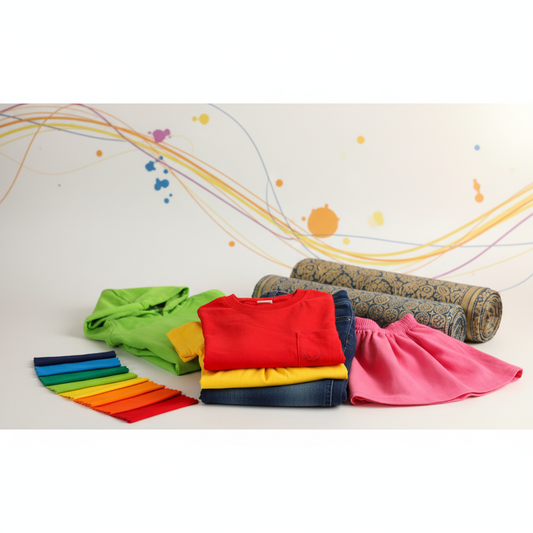
Getting Stitching Workers for Our Unit Was a Challenge — Here’s the Truth Behind Small-Scale Manufacturing
If you’ve ever wondered what goes on behind the scenes of a kids clothing brand like ours, here’s a truth that may surprise you: manufacturing is not just about machines, fabrics, or designs — it is primarily about people.
Skilled people. Reliable people. People who can bring quality to life with their hands.
And getting skilled manpower in the manufacturing industry, especially in Tiruppur, is one of the toughest challenges for any small brand.
This is the story of our journey — and the challenges we faced in building a manufacturing unit that can match the quality we promise.
1. Why Skilled Manpower Is the Backbone of Manufacturing
In the textile industry, especially in kids clothing, the quality you hold in your hand is the direct result of:
-
How precisely the fabric was cut
-
How consistently each piece was stitched
-
How carefully it was ironed
-
How thoroughly it was checked
-
How passionately a worker approached their craft
Machines only assist; it is the people who actually create the product.
That’s why finding qualified manpower is arguably the most important — and also the hardest — part of running a manufacturing unit.
2. The Talent Gap: Skilled Workers Are Hard to Find (And Harder to Retain)
Every manufacturing business, big or small, faces one common problem:
shortage of skilled manpower.
Tailors, cutters, ironing professionals, checking staff — all of them prefer:
-
Long-term jobs
-
Continuous monthly income
-
Stability
-
Predictable work flow
Unfortunately, not all businesses — especially young, growing brands — can offer this immediately.
And this is exactly where our struggle began.
3. Our Biggest Challenge: We Do Not Yet Have Continuous, Year-Round Production
We are a small company.
We are growing, yes — but we are growing step-by-step.
Our production currently happens in batches, based on:
-
Season
-
Demand
-
New launches
-
Inventory cycles
This means we do NOT run a continuous, all-year-round manufacturing line.
Our volumes — at this stage — do not support a full-time workforce.
While we are committed to quality and consistency, the truth is simple:
We cannot keep 30–40 workers engaged every single day of the year — yet.
4. Why Batch Production Makes Hiring Difficult
Here’s what happens when you run batch-based production:
-
You need more tailors when a big batch starts
-
You need fewer tailors when the batch ends
-
You cannot guarantee monthly stability
-
Skilled workers feel insecure because work isn’t steady
And in the world of garment manufacturing, insecurity is the biggest reason workers don’t stay.
Workers are not wrong. They have families to support, rent to pay, and expenses that continue regardless of our production cycle.
So naturally, they prefer companies offering 12 months of continuous work — even if the pay is the same.
5. Tailors, Cutters, Ironing & Checking Staff — Everyone Wants Stability
This problem is not limited to tailors alone.
Whether it is:
-
Stitching workers
-
Cutting masters
-
Ironing staff
-
Checking personnel
-
Helpers
all of them want the same thing: stable monthly work.
And right now, our scale of production is not yet large enough to offer continuous employment all year round.
This created a cycle:
-
We hired skilled tailors
-
Production slowed after a batch
-
They looked for long-term work elsewhere
-
We had to hire again
-
Training new workers slowed us again
It became a loop that every small manufacturing brand understands too well.
6. Retaining Skilled Workers: Why They Didn’t Stay With Us
We tried our best to retain good talent.
But the challenge was bigger than us.
A tailor would stay for a month, two months, maybe three — and then say:
“Sir, I need stable work. I have to join a bigger unit.”
Or:
“After this batch, will there be work next month?”
And when we could not give a 100% guarantee, they moved on.
The result?
We had to restart training repeatedly.
Each batch became slower.
Productivity dropped.
Costs increased.
Production timelines stretched.
This is the hidden struggle customers never see — but every small manufacturer feels daily.
7. The Reality of Being a Small Brand Trying to Grow
Growth is not instant.
It takes:
-
Time
-
Capital
-
Inventory planning
-
Forecasting
-
Market consistency
-
Customer trust
-
And patience
We might look like a smooth-running brand on the outside, but behind the scenes, we were constantly juggling:
-
Worker shortages
-
Production delays
-
Training new tailors
-
Maintaining quality
-
Ensuring timely deliveries
Despite these challenges, we kept pushing — because quality is non-negotiable for us.
8. How Workforce Instability Affects Quality & Timelines
When workers keep changing:
-
Stitching consistency varies
-
Speed reduces
-
Checking errors increase
-
Quality control becomes harder
-
Production takes longer
-
Costs rise
-
Planning becomes unpredictable
But even through these setbacks, we refused to compromise.
If a batch took longer, it took longer — but we wouldn’t release it until it was perfect.
This commitment to quality is what helped us grow, even when manpower challenges slowed us down.
9. The Turning Point: Understanding What We Truly Need
After months of trial and error, we learned three important lessons:
-
We need a semi-stable core team, not a full 40-member unit
-
Batch-based production can work smoothly with the right planning
-
As our online sales grow, production will naturally stabilize
We are still small — but we are building the roots for long-term stability.
10. How We Plan to Overcome This in the Coming Year
We now have a clear plan for the next 12–18 months:
✔ More consistent production cycles
Instead of irregular batches, we plan to produce smaller but more frequent lots.
✔ A stable core team of skilled workers
We will retain a fixed set of tailors and add temporary staff only during big orders.
✔ Better forecasting through online sales data
Sales trends will help us plan production with more predictability.
✔ In-house training
We hope to train new stitchers ourselves to maintain consistency.
✔ Long-term investment in workforce stability
As orders grow, we aim to offer year-round employment — a big milestone for any small manufacturer.
This journey is not easy, but it is happening one step at a time.
11. Final Thoughts: The Hidden Challenges Behind Every Garment
When customers hold a soft cotton T-shirt or pajama set from us, they see:
-
Comfort
-
Colour
-
Fit
-
Quality
-
Style
But behind every garment are:
-
Skilled hands
-
Hours of labour
-
Human challenges
-
Manufacturing complexities
-
Scheduling hurdles
-
Workforce struggles
-
And constant effort
We want you to know this story because your support directly helps us grow, stabilize, hire more workers, and eventually run a continuous, year-round manufacturing unit.
And with your trust, we know we will get there.








